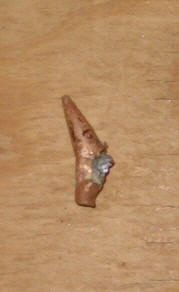



In summary, the comparison of the larger 90 & 100 grain bullets with the faster 55 grain does indicate a more reliable fragmentation with the varmint bullet, but only slightly so, with two relatively large fragments of the little bullet carrying the bulk of energy downrange. It also seems to confirm the projection of less energy downrange after an initial ground strike with the varmint bullet, but again only a slight difference. On balance I would say the dangers to people and property in the shooters background are roughly the same. When the larger slower bullets held together, they did so with little retained velocity and extremely poor aerodynamics when we envision the long tumbling slug on it's way downrange, trying to cut the air with a sideways orientation through much of the time of flight. If we look at the bullet to the left we might theorize that the slug jacknifes upon contact with the ground. If the 90 grain was to produce two major fragments by breaking in the middle, the length of these as they tumble is still likely to significantly retard their flight. By contrast the high velocity fragments from the varmint bullet are likely to be more compact and aerodynamic.
But all this is still of little use if we don't know how far downrange our low angle shots remain dangerous. Taking a cylindrical fragment consisting roughly of 1/2 of the 90 grain bullet at the left we will use basic ballistics and a few leaps of faith to build a worse case scenario and follow the stray richochet though it's flight to see what develops.
Lets suppose that our cylindrical fragment is 40 grains and manages to leave it's contact with the ground at a velocity of 2800 feet per second at an angle of 4 degrees. Using a the coefficient of form for a cylindrical blunt projectile I calculated a Ballistic Coefficient for our fragment. When done for the fragment flying while in the lengthwise orientation the B.C. was .041. For the time the tumbling fragment spends in the sideways position a B.C. was roughly (very roughly) calculated to be about .019. To truly calculate a single B.C., even a rough one, for a tumbling projectile without chrono data would probably take either an advanced degree in physics, or possibly a slingshot and a chronograph, and I don't have either option at my disposal. So to give a single B.C. to our spinning fragment I'll cheat and take the mean of the ballistic coefficients for the sideways and lengthwise flight orientation. In reality the dynamics of air flow over this thing as it tumbles would probably put the B.C. much lower, but remember, we want a worse case scenario anyway. Plugging our data into Bear tooth Bullets online ballistics calculator yielded the following results.
100 yards: Our bouncer is on it's way up because of the angle at which it left the ground strike. It is moving at a lethal velocity of 910 feet per second, but is about 41 feet above the ground.
200 yards: The fragment is still on it's way up, now about 83 feet above the ground. As a 40 grain chunk of lead, it still has a dangerous velocity of 580 feet per second, about that of pellet from a Daisy 880 air rifle.
300 yards: Our fragment is now about 11.5 stories up, and moving still higher. It's now going 372 feet per second. If it hit you at this speed, it's probably going to hurt like crazy, maybe even penetrate, eye damage is a definite possibility. Penetration of buildings or cars is not too likely.
400 yards: The fragment has now topped out about 12.5 stories up and is beginning to fall. It's forward velocity has dropped to 232 feet per second or 157 miles per hour. This is just below the velocity of an arrow from a compound bow. At this speed it is not likely to inflict serious harm to life and property short of an eye injury.
500 yards: Still 76 feet up and down to a velocity 148 feet per second our 40 grain fragment has now started falling fast.
550 yards: Our fragment finally hits the ground going 127 feet per second. Just a little slower than a major league pitcher could have thrown it at you.
So does this mean we don't have to worry about hitting anything past 600 yards on a bounced shot? Certainly not. With each shot fired being a unique event nobody can say with much confidence how far away people and property will be threatened on a given shot, but with a little common sense the shooter should be able to select his background cautiously, and safely fire, even in Indiana where farmsteads dot the countryside. The tests presented here seemed to show that shots toward unseen persons or buildings behind concealing trees or brush, or shots taken over higher terrain producing no ground strike will offer a much greater hazard to very distant areas than ricochets. Anyone whose had a ricochet fly overhead before knows that even a bouncer with little dangerous velocity left is likely to get you into trouble if it flies remotely close to listening ears. A chunk of lead spinning with great velocity and making that whirring sound is not going to be welcome! Frangible varmint bullets definitely don't appear to be the answer to safe shooting that some believe, as the fragments they produce after hitting the deck can be significantly large and moving quite fast. Care should be taken when shooting frangible bullets just as when shooting deer bullets. A little common sense in the field and the willingness to pass up a shot for a safer one later should be able to make a safe hunter out of any Indiana caller.
Be Safe and Hunt Hard
Weedwackr BACK HOME
